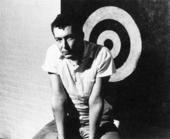In the late 1950's, Jasper Johns emerged as force in the American art scene. His richly worked paintings of maps, flags, and targets led the artistic community away from Abstract Expressionism toward a new emphasis on the concrete. Johns laid the groundwork for both Pop Art and Minimalism. Today, as his prints and paintings set record prices at auction, the meanings of his paintings, his imagery, and his changing style continue to be subjects of controversy.
In New York, Johns met a number of other artists including the composer John Cage, the choreographer Merce Cunningham, and the painter Robert Rauschenberg. While working together creating window displays for Tiffany's, Johns and Raushenberg explored the New York art scene. After a visit to Philadelphia to see Marcel Duchamp's painting, The Large Glass (1915-23), Johns became very interested in his work. Duchamp had revolutionized the art world with his "readymades" a series of found objects presented as finished works of art. This irreverence for the fixed attitudes toward what could be considered art was a substantial influence on Johns. Some time later, with Merce Cunningham, he created a performance based on the piece, entitled "Walkaround Time."
The modern art community was searching for new ideas to succeed the pure emotionality of the Abstract Expressionists. Johns' paintings of targets, maps, invited both the wrath and praise of critics. Johns' early work combined a serious concern for the craft of painting with an everyday, almost absurd, subject matter. The meaning of the painting could be found in the painting process itself. It was a new experience for gallery goers to find paintings solely of such things as flags and numbers. The simplicity and familiarity of the subject matter piqued viewer interest in both Johns' motivation and his process. Johns explains, "There may or may not be an idea, and the meaning may just be that the painting exists." One of the great influences on Johns was the writings of Austrian philosopher Ludwig Wittgenstein. In Wittgenstein's work Johns recognized both a concern for logic, and a desire to investigate the times when logic breaks down. It was through painting that Johns found his own process for trying to understand logic.
n 1958, gallery owner Leo Castelli visited Rauschenberg's studio and saw Johns' work for the first time. Castelli was so impressed with the 28-year-old painter's ability and inventiveness that he offered him a show on the spot. At that first exhibition, the Museum of Modern Art purchased three pieces, making it clear that at Johns was to become a major force in the art world. Thirty years later, his paintings sold for more than any living artist in history.
